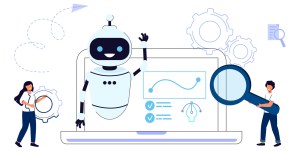They may not always be able to see it, but the best service agents have a way of making even the angriest or most disappointed customers smile.
Sometimes the change in mood comes from helping resolve a misunderstanding over how a process works, like returning an order or getting a credit.
There are other situations where service agents talk customers through features they couldn’t figure out how to use on their own, despite frequent attempts.
In the worst scenarios, service agents can still offer value when there’s nothing else to be done by offering taking the time to truly listen to customers and demonstrating empathy.
Agents are in a much better position to bring this level of humanity to the work they do when they are not bogged down by all the other customer service tasks that don’t make the best use of their time and talent.
This not only includes all the information they once had to scour through disparate databases and filing systems to find. They also work at their peak when they’re not being given low-level, repetitive kinds of service requests that, quite frankly, customers would probably rather tackle themselves.
Automating your customer service operation can take many forms, but building your business case to do it should be predicated on achieving two different goals at once.
First, service automation should be part of a strategy to enhance the customer experience you offer. It should help anticipate and address all the potential issues that come up after a customer has made a purchase and before they make their next one.
Secondly, customer service automation should lead to a positive transformation in your agents’ employee experience. It should allow them to channel their energy and experience into the requests that require a deeper level of problem-solving, allow them to build upon their skills and add the human touch to customer service where and when it matters most.
This is just a partial list of customer service automation opportunities the average business should consider:
1. Rewrite your FAQ pages
This isn’t considered “automation” in the classic sense but it can be a great way to begin understanding where your customers truly need to engage with an agent. Make sure you’re leveraging the data from service interactions to update and provide more detailed answers to frequently asked questions (FAQ) and you might deflect a number of calls to your contact center.
2. Standardize E-mail Auto-Responses
Agents shouldn’t need to write an immediate reply to every e-mail that comes into the support account. In many cases customers simply want confirmation their message was received and an estimated time for when they can expect more detailed assistance.
You can go even further with e-mail auto-responses by including links to blog posts, user manuals, explainer videos and other resources related to the most typical problems customers have.
3. Publish A Knowledge Base
The first thing many of your customers probably do when they’re looking for help is to enter a query into a search term like Google. They might find what they’re looking for that way, but the risk is that they’re directed to misleading or false information. Having your own knowledge base avoids that and can become the first links they discover in their list of search results.
Companies used to find writing and updating knowledge bases onerous and time-consuming, but today the information culled from service interactions can help streamline the process considerably. A great knowledge base is always a work in progress, but it can reduce customer service costs considerably.
4. Deploy interactive voice response (IVR)
There are few phrases that can make a chill run down customers’ spines like, “Hold on, I’m going to transfer you.” They know there is a chance the agent needs to keep them waiting while they look up the best colleague to assist them, and that their call might even be dropped. IVR offers completely different scenario.
When customers reach out with a problem, IVR acts like an expert tour guide, routing them directly to the agents with the right training or seniority level to provide the right level of service.
5. Offer chatbots and virtual assistants
As we see more customer experiences increasingly shift to digital channels, it no longer makes sense to assume that everyone is going to pick up the phone and reach out to a contact center when they’re looking for help. If they’re visiting a web site, for instance, they would probably rather be able to have their complaint handled or their questions answered directly and immediately. Enter the chatbot.
While some chatbots are linked to live agents, they can also offer considerable self-service capabilities by being trained in the data about routine issues and fixes. This can be a simple, intuitive way for customers to pursue self-service with your brand, while still allowing the option to transfer them to a human agent as required. When chatbots are fuelled by artificial intelligence (AI), they can even “learn” through each interaction and continuously improve.
6. Send instant feedback surveys
Service agents have traditionally wrapped up a lot of customer interactions by asking the same list of questions to ensure they’ve addressed the request and perhaps to have the customer rate the quality of their experience. This can add more time on the agent’s end, without allowing for them to offer any additional value.
When feedback surveys can not only be automated, they save agents time while providing an ongoing stream of data that can provide even more actionable insights to companies that want to take their customer service operations to a new level.
Regardless of what kind of customer service automation you use, make sure you’ve determined the right goal and the best way to measure your results. Want to reduce customer churn and increase sales? Customer satisfaction (CSAT) might be the right metric to pair with your automation solution. For those that are more focused on agent productivity and performance, it might be better to track the number of tickets resolved but correlate it with CSAT.
Best of all, customer service automation isn’t reserved for the world’s largest organizations. The technology can work for businesses of all sizes that want to make customer service a core pillar in building long-lasting relationships with their team and those who purchase from them.

























